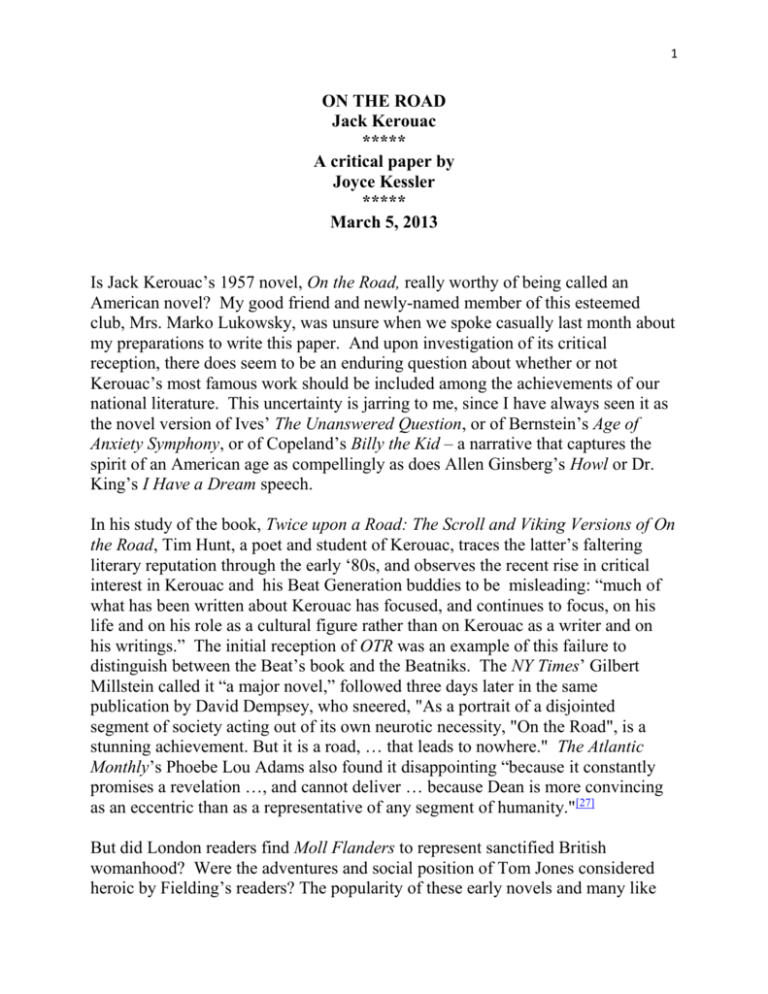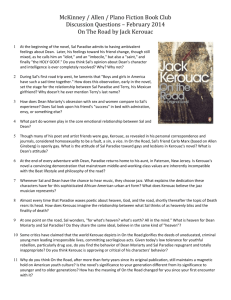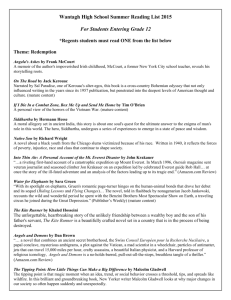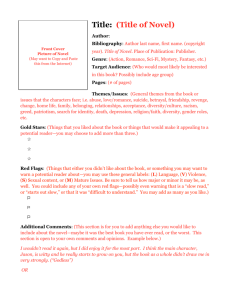on_the_road0313
advertisement

1 ON THE ROAD Jack Kerouac ***** A critical paper by Joyce Kessler ***** March 5, 2013 Is Jack Kerouac’s 1957 novel, On the Road, really worthy of being called an American novel? My good friend and newly-named member of this esteemed club, Mrs. Marko Lukowsky, was unsure when we spoke casually last month about my preparations to write this paper. And upon investigation of its critical reception, there does seem to be an enduring question about whether or not Kerouac’s most famous work should be included among the achievements of our national literature. This uncertainty is jarring to me, since I have always seen it as the novel version of Ives’ The Unanswered Question, or of Bernstein’s Age of Anxiety Symphony, or of Copeland’s Billy the Kid – a narrative that captures the spirit of an American age as compellingly as does Allen Ginsberg’s Howl or Dr. King’s I Have a Dream speech. In his study of the book, Twice upon a Road: The Scroll and Viking Versions of On the Road, Tim Hunt, a poet and student of Kerouac, traces the latter’s faltering literary reputation through the early ‘80s, and observes the recent rise in critical interest in Kerouac and his Beat Generation buddies to be misleading: “much of what has been written about Kerouac has focused, and continues to focus, on his life and on his role as a cultural figure rather than on Kerouac as a writer and on his writings.” The initial reception of OTR was an example of this failure to distinguish between the Beat’s book and the Beatniks. The NY Times’ Gilbert Millstein called it “a major novel,” followed three days later in the same publication by David Dempsey, who sneered, "As a portrait of a disjointed segment of society acting out of its own neurotic necessity, "On the Road", is a stunning achievement. But it is a road, … that leads to nowhere." The Atlantic Monthly’s Phoebe Lou Adams also found it disappointing “because it constantly promises a revelation …, and cannot deliver … because Dean is more convincing as an eccentric than as a representative of any segment of humanity."[27] But did London readers find Moll Flanders to represent sanctified British womanhood? Were the adventures and social position of Tom Jones considered heroic by Fielding’s readers? The popularity of these early novels and many like 2 them was due to their depiction of “novel” lives, of the problems of the “low” character, fighting her or his way upward from one social level to the next, grabbing any opportunity – legitimate or not – to build a new and better life. If not the revelation of the new, what is it that gives any novel its social and/or aesthetic value? What are the standards that have been applied to this genre, and what of these are relevant to apply to OTR? What were Kerouac’s aesthetic ambitions for his narrative, for its social relevance, its philosophic range, its place within the tradition of the form? Some randomly but fortuitously encountered statements on these questions started me going in a certain direction (so to speak). The “New Books” review section in this year’s March issue of Harper’s Magazine begins with the following bold claim by novelist Jane Smiley: “Since Don Quixote, the essential subject of the novel has been geography: what is out there, who lives there, how they are different from characters who live in other landscapes.” Then, in the Introduction to Henry James’ Portrait of a Lady (a novel that I can’t seem to stop rereading), I found an intriguingly familiar pronouncement by Richard Chase: “The American novel, in its most original and characteristic form, has worked out its destiny and defined itself by incorporating an element of romance.” Chase’s words resonate with me: in Cervantes’ imagination, the medieval romance bloomed into the grandfather of the novel. Hawthorne elaborated the romance element into four separate novels that he specifically titled romances, and Hawthorne’s great fan, Melville, relied on the allegorizing power of the romance in many of his mid-tolate career writings, such as Moby-Dick, Pierre, and The Confidence Man. While I’m thinking of Dean Moriarty, I often think, too, of the Knight of the Mournful Countenance, of Donatello, of Captain Ahab. The importance of the romance to the American novel is quite obvious. Smiley, too, has her point: whether in search of windmills, women, or whales, these characters’ journeys across enchanted landscapes have long compelled wonder and fear in readers. The lure of Kerouac’s novel to the readers of the prosperous ‘50s was, however, not quite so obvious. For the growing and predominantly white middle class of Americans who may have read (or gave up trying to read) OTR , the boom in employment prospects, home ownership, and disposable income was embraced as a validating reward for America’s heroic contributions to ending the Second World War. There was a culture of satisfaction among this highly visible social group: they were inventing a new peace-time cultural standard, starting prosperous communities and precious families who worked hard, educated themselves well, played by the rules, and loved to buy new toys. Their favorite among these was the automobile. The car mobilized and freed the members of this new society. 3 Improved roads and individual access to transportation made driving a symbolic act of Americanism. Sixties historian Todd Gitlin has characterized it as “the incarnation of personal power, freedom, leisure, sex, access, efficiency, ease, comfort, and convenience.” Gitlin also saw the car as a “liberator” of individuals from the “social restraints” of mainstream ‘50s culture. Was such liberation widely perceived as needed, or was mainstream post-war American culture unchallenged by any of its constituent parts? Certainly the escalating Cold War and fear of “the Bomb” threw a shadow over the mood of consumer gaiety. And the reigning intellectual elite warned of the dangers of “the American way of life” in books like The Lonely Crowd, The Organizational Man, The Affluent Society. The party kept going, but the basic conflict was understood: prosperity had bred an American cultural unity as the standard ideology, and any one or any group differing in interests or identity – the non-white, the poor, the mentally ill, the homosexual – was seen as a threat to that unity and was socially marginalized. Enter the Civil Rights Movement and the Beat Generation. As we know, Kerouac began thinking about this narrative during his cross-country trips with Neal Cassady in the late ‘40s. Stories of his struggles to write it in 1951 are well known, as are the stories of his struggles with his publishers, so that the 1957 publication of the book by Viking Press placed it before an American reading public that was still keenly enjoying the crest of its post-WWII prosperity and trying not to flinch too much in response to the Civil Rights Movement drama unfolding in the Southern states. OTR was published in the same year that Arkansas’ Little Rock Central High School was desegregated. Kerouac’s ambitions for the work were formed, in part, by the influence of his friends, Beat poets and artists. Like Allen Ginsberg, he turned to the music that he heard in jazz clubs in Greenwich Village and San Francisco to find a sentential “sound,” a prose rhythm that would be suitable for his narrative of the down-and-out, the beat. Kerouac’s composing process went through three stages. A first version of OTR featured different characters. The second version – it has been claimed – was completed in three weeks of continuous writing, in scroll form. It came to 120 yards and 186,000 words in length, and the writer confided, “Rolled it out on floor, and it looks like a road.” The third version began six months after Kerouac finished the scroll. He had heard Lee Konitz, a top alto sax player, at Birdland, and connected Konitz’ phrasing to a suggestion by his friend, Ed While, that he might try making “verbal sketches.” The sketches grew into what Kerouac called “wildform … undisturbed flow from the mind of personal secret idea-words, blowing on subject of image.” He saw the advantages of wildform (also called bop prosody or spontaneous prose) as “egoless and unjudging”; an associative key into 4 a world of sensation and memory. “Blowing,” based on breath duration, jazz improvisation, and “moment to moment truth” linked fruitfully in certain passages of his third version of OTR. Yet it isn’t just wildform that can be heard in the passages describing different parts of the American landscape as Sal and Dean traversed it. Surely Kerouac’s tale can be said to satisfy Smiley’s condition for the novel: in the cross-country discovery of places, it also explores people and ghosts. He shows us a vast, numinous geography. A bar in Central City, Colorado is both a riotous watering hole in a wilderness and a spiritual search site: Great laughter rang from all sides. I wondered what the Spirit of the mountain was thinking, and looked up and saw jack pines on the moon, and saw ghosts of old miners and wondered about it. In the whole eastern dark wall of the Divide this night there was silence and the whisper of the wind, except in the ravine where we roared, and on the other side of the Divide was the great Western Slope and the big plateau that went to Steamboat Springs, and dropped, and led you to the Eastern Colorado desert and the Utah desert; all in darkness now as we fumed and screamed in our mountain nook, mad drunken Americans in the mighty land. We were on the roof of America and all we could do was yell, I guess – across the night, eastward over the Plains, where somewhere an old man with white hair was probably walking toward us with the Word, and would arrive any minute and make us silent. (47). As Sal follows Dean over the myriad geologic variations of this country, mining them for their local flavors and hints of cosmological and human truths, each is in pursuit of his own brand of revelation. This type of character pair and their odyssey is, of course, not at all an unfamiliar formula in the American novel. Prompted by the “damp, drizzly November in [his] soul,” Ishmael very purposefully seeks out a sea voyage that he hopes will ultimately yield a soul-correcting revelation. He readily succumbs to the lure of his “old hunks of a sea-captain”, Ahab, despite the fact that he clearly sees the latter’s delusion. He follows him, mesmerized, crisscrossing ocean paths, through brit meadows, whirlpools, epic storms, and bloody battles with symbolic Leviathans, at some level of consciousness hoping that the act of witnessing Ahab’s theater of revenge will end in his own salvation. The outlines of Dean and Sal have been traced in other such novelistic pairs. Though they may be odious, 5 The Observer’s Sean O’Hagan makes a similar comparison in defense of Kerouac’s place on the American novel honor roll: Junior Burke, chair of writing at Naropa, recently described On the Road as ‘one of the truly defining works of American fiction’, comparing it to The Adventures of Huckleberry Finn, but adding: ‘Instead of two guys on a raft on the Mississippi, it's two guys in a Hudson Hornet on the highways of America.’ Or why not two guys on a beat-up horse and a donkey, roving the south-central Spanish countryside in search of their ideal careers? The self-anointed knight and his governor-hopeful squire comprise the Ur-character pair of the novel form, and there is much in the design of Kerouac’s narrative that can be connected back to Cervantes’ narrative design. The urgent call to adventure, the unfocused desire to rediscover a beautiful moral standard, the search for the past in the present – all of these elements, it can be argued, are eerily alive in both books. And that most important element of all – Chase’s element of romance – is a salient feature of both. The tales of knight errantry and the beauties of the Chivalric code, passionately relived and hilariously mocked in the first book of DQ, both reach back in yearning to the romance tales of Europe’s 11th and 12th centuries, and at the same time, offer a critique of their ideals. Sancho Panza never does get his island governorship, Don Quixote never does win – or even find – his Dulcinea. Sanson Carrasco, that first psychotherapist, forces the Knight of the Mournful Countenance to confront the lunacy of his knighthood. On his deathbed, Quixote relinquishes his “blazon [of] pity,” and “his banner [of] beauty.” In the first novel, Cervantes created a romance quest that ends in a denial of the grail’s existence. Dean’s search for his father (the past) often melds into his search for his proliferating lady loves (the present), but his Holy Grail is the art and knowledge that was missing in his Denver childhood. His hunger for the life of the writer, of the mind, of meditation as action drives him toward relationships with Carlo Wolf and Bull Lee. An evening spent on Long Island with a self-styled scholar, Rollo Greb, appears at first to Dean to yield the secret cache: Yes … Yes … Yes. … That Rollo Greb is the greatest, most wonderful of all. That’s what I was trying to tell you – that’s what I want to be. I want to be like him. He’s never hung-up, he goes in every direction, … he knows time … Man, he’s the end! You see, if you go like him all the time you’ll finally get it. Get what? 6 IT! IT! (106) But Dean’s hunger is his demon, and he is therefore always restlessly off on another junket to find IT, Sal following in the hope that, somewhere, the dope and the parties and the excitement of the ideas and the music will lead them to “the moment when you know all and everything is decided forever.” (107). Who or what is Sal following? Perhaps Kerouac articulates it best when Sal at last understands – listening to a chorus of disappointed females criticizing Dean – that his leader is “the Holy Goof”: I suddenly realized that Dean, by virtue of his enormous series of sins, was becoming the Idiot, the Imbecile, the Saint of the lot. … That’s what Dean was, the HOLY GOOF. (160) If, as Nabokov saw, Don Quixote’s banner had “beauty” written on it, and stood for “everything that was gentle, forlorn, pure, unselfish, and gallant,” the Holy Goof’s banner has IT!! written on it, and stands for everything that is lost, lovestarved, driven by appetites, and murky of vision. He appears at first as the beaten outsider whose identity tantalizingly promises to emerge before Sal’s eyes, a casualty of American life begun in parental abandonment, a remorseless exploiter of any of the country’s riches that he can lay his hands on, by foul means or fair. Sal senses a theater of retribution in Dean’s ceaseless yearning and taking, a kind of implicit ironic moral critique of ‘50s American dreaming in the ongoing jailbreak that sums up Dean’s life on the road. As Don Quixote’s knight-errantry became increasingly evident as a delusion to his squire and supporters, the increasingly repetitive fruitlessness of Dean’s road trips begins to become evident to Sal. The road leads over a cliff: as his father abandoned him, so Dean abandons wives, children, and finally a desperately sick Sal, in Mexico. The question that Dean’s life asks of America can no longer be heard by those who followed and loved him; it has become apparent to Sal that there is no pearl. Sal’s ultimate abandonment of Dean in New York City ends yet another quest narrative with yet another denial of the Holy Grail. And yet, these two works leave us with a hopeful afterimage of the glorious chivalry of the Middle Ages, the “novel” idea, for the dominant culture of the postwar ‘50s, of sympathy for the dispossessed, the hinted potential of the American Dream to make a place for Dr. King’s dream. The legacy of OTR is that through this novel, the Beat Generation opens questions for the Greatest Generation and the Gray Flannel ’50’s, finally directing an urgent call for answers to the Baby Boom 7 Generation. One can easily see ‘60s novelist Ken Kesey and his madman visionary character, Randle McMurphy as descendants of the narrative tradition I’ve outlined here. The new novel form of the ‘60s New Journalists traced similar figures of epic insanity – Tom Wolfe following Ken Kesey and his Merry Pranksters (while Neal Cassady drives Further, the magic bus) in The Electric Kool Aid Acid Test, Hunter Thompson following the Hell’s Angels in his eponymous journal of the lives of outlaw bikers, scenes of Allen Ginsberg and the Yippies levitating the Pentagon in Norman Mailer’s Pulitzer-winning nonfiction novel of the anti-Vietnam War movement, Armies of the Night. Flowing from Kerouac’s wildform into the ‘60s and forward to the contemporary literary scene is the nowthriving genre of creative nonfiction and its rebel cousin, hybrid fiction. These contemporary literary forms are, for me, clear descendants of the traditional literary expression American life and culture, and Kerouac’s novel of the Beats takes the first steps on the road to now. But perhaps this is one of those judgments on which the world – and maybe this club – divides? ***************************************************************** Discussion Questions 1. What understanding of the Beat Generation does this novel give its readers? Do we have a broad sense of what is included in the term “beat”? Do you think that Kerouac wrote the book to explain or justify the Beats? 2. Sal seems to derive a lot of meaning from his cross-country journeys: he is always characterizing “the West”’, with which he is largely unfamiliar, vs. the “East”, which he knows, but which is showing him a new face, nonetheless. What do you think Sal is trying to discover in the West? What excites him about the East? Do his distinctions resonate with common contemporary characterizations of these places? Do they resonate with you? 3. How does this novel speak to the high social value of the car in the ‘50s? What are some aspects of the characters’ lives that can be symbolized by the road? 4. Is Old Dean Moriarty a figment in this novel’s imaginative arc? Do Dean’s father or any of the novel’s other old man-ghosts invite contemplation of a more profound aspect of American character, or is he literally the lost paternal figure in Dean’s lost mind? 8 5. During the first half of the novel, Sal is very attracted to the person and the idea of Dean. Marylou, Camille, and Inez can’t seem to resist becoming entangled with him. What do Sal or any of Dean’s women see of value in him?








